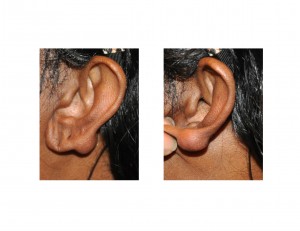Background: Keloid scars are one of the most difficult scar problems. They are hard to stop growing and removing them is no guarantee that they will not return. Their high recurrence rate is well chronicled. One of the reasons keloids can recur is that they are incompletely excised. Leaving but just a miniscule amount of keloid behind is all that it takes for it to regrow.
The ears are a frequent site of keloid development, particularly in the higher risk African-American patient. The high frequency of ear piercings, particularly multiple piercings, is the cause. While it will likely develop from an infected or complicated piercing, it can develop years later for no apparent cause also. The small size of the earlobe makes complete removal problematic if the keloid is of any size and one wants to maintain a normal earlobe shape.

Surgical resection was done by removing the entire keloid from the back of the ear as well as the involved earlobe hole. This left a large open wound on the back of the ear. Trying to close it would have left a small and distorted-looking earlobe. A full-thickness skin graft was taken from a more superior portion of the junction between the back of the ear and the mastoid skin. The donor site was closed primarily. The skin graft was sewn into the defect with small resorbable sutures.


Case Highlights:
1) Ear keloids are very common and are caused by piercings. They usually start on the back of the ear. Once they develop, they often continue to grow and may be refractory to steroid injections.
2) The typical size of many keloids and the small surface area of the earlobe makes earlobe distortion likely with excision and primary closure.
3) Earlobe distortion can be prevented with keloid removal and ear reconstruction by full-thickness skin grafting of the defect. This approach gives one more leeway to remove the full extent of the keloid as severe earlobe deformity afterward is less likely.
Dr. Barry Eppley
Indianapolis, Indiana


